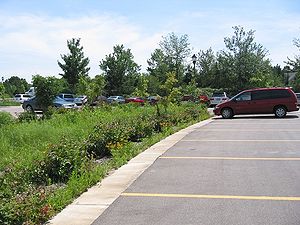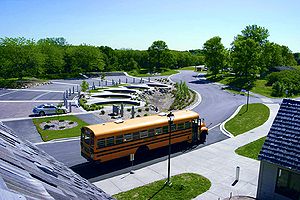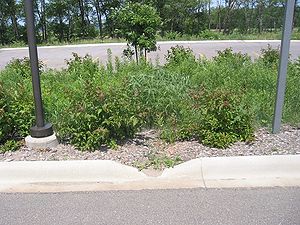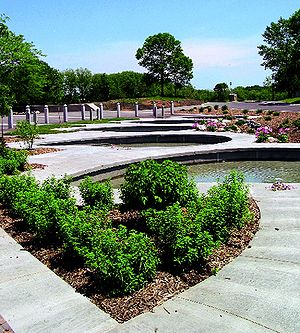
University of Minnesota Arboretum - runoff model and rain gardens
There are few, if any, public models demonstrating water runoff absorption solutions. The runoff model parking lot and the rain gardens attempt to demonstrate several actions that can increase absorption and thereby decrease runoff from hard surfaces and also demonstrate the relative difference it makes. These particular sites, similar to sites throughout the Twin Cities Metropolitan area, have heavy clay/silt soils.
Project summary
- Location: Chanhassen
- Landscape Setting: Suburban
- Drainage area: Runoff Model = 25,000 square feet, Rain Gardens = 18,000 square feet
- Project timeline: Runoff Model 2002, Rain Gardens 2003
- Project cost: Runoff Model $ 550,000; Rain Gardens $ 200,000
- More information: Andersen Horticultural Library, Minnesota Landscape Arboretum
Background
As the urban landscape has become more highly developed, polluted storm runoff has emerged as a major problem. When pavement, rooftops, and other hard surfaces replace grass, trees, and native plants, then rain and melting snow can no longer seep slowly into the earth. Instead, stormwater flows over these hard surfaces, picking up pollutants such as oil, fertilizers, and pesticides and depositing them in storm sewers that eventually lead into natural water bodies such as local lakes and streams. Serious water quality problems are the result of this phenomenon.
Rain gardens and absorption devices represent alternative stormwater management practices, using vegetation and innovative design features to improve water infiltration and maximize pollutant removal. An accessible runoff model and rain gardens at the Minnesota Landscape Arboretum demonstrates for urban planners, landscape designers, city officials, and the general public the potential positive impact of these important and replicable tools for stormwater runoff management.
Rain gardens and absorptive surfaces may be suitable for any land use situation, including industrial, commercial, and residential. Therefore, target audiences for these demonstration projects include architects, engineers, city planners, other public officials, watershed managers, hydrologists, legislators, and homeowners.
Commercial developers and public officials face increasing regulations related to stormwater management and wetland mitigation. The runoff model demonstration project and the rain gardens offers alternative strategies to consider that enhance the appearance of parking lots and other projects, at the same time lessening potential detrimental impact on water quality.
Homeowners are interested in learning about rain gardens, incorporating plantings to attract birds and butterflies and about reducing pollutants reaching natural community water bodies. In addition, homeowners who seek permits for additions to their home structures benefit from ideas such as converting driveway “hard structure” into a “non-hard cover” such as “grass-crete” or permeable paving units.
In 2001 the Arboretum decided to add to its display of runoff water disposal/purification alternatives by creating a runoff water disposal model in a new parking lot. It would demonstrate the difference between nearly 100 percent runoff to nearly 0 percent runoff.
These parking lots are used by visitors and staff at the Marion Andrus Children’s Learning Center at the Arboretum. They are set within the Arboretum boundaries and are surrounded by maple-basswood-oak forest and wetlands (mostly deteriorated).
Project objectives included the following:
- Demonstrate new design paradigms for parking lots and other “hard surface” developments, including curbless paving and a variety of bioretention techniques related to reducing stormwater runoff and sediment.
- Demonstrate a variety of applicable materials for paving, planting and filtering.
- Demonstrate remedial techniques for use with existing pavements, including infiltration strips and crosswalk edges.
- Demonstrate attendant techniques for treating stormwater quality, such as planted filter swales and sedimentation basins.
- Record, compare, and disseminate longitudinal observations about costs and effectiveness of each of the five rain garden segments.
- Educate visitors about the importance of effective stormwater runoff management in assuring urban ecological well being.
Implementation
The runoff model consists of five clearly defined areas of equal size, each with a different level of runoff infiltration and each draining to its own ponding area or sump where the quantity of runoff can be observed and compared, one area to another.
The five distinct areas are separated by concrete access/watershed dividers and consist of the following:
- Bituminous parking area with adjacent paved slope and paved filter area, a worst case scenario included for comparison purposes.
- Bituminous parking area with adjacent lawn slope and lawn filter area.
- Bituminous parking area with a vegetated island, and adjacent vegetated slope and lawn filter area.
- Bituminous parking area with rock filled trench drains, adjacent vegetated slope and vegetated filter area.
- Permeable pavement or “grass-crete” parking area with rock filled trench drains, adjacent vegetated slope and vegetated filter area.
A photographic record of the installation process has been maintained. Each overflow pool or catchment area is designed so that accurate measurements can be taken. The time to construct this as a model would not reflect the costs of installing any one of the five model watersheds. Obviously installment of a porous paver surface is more time consuming but hugely more effective in absorbing water.
Adjacent to the runoff model is a parking lot with swaled rain gardens. The swales have 2 feet of sand topped with 6 inches of sandy top soil and planted with drought resistant (mostly native) plants. A subsurface drain below the sand and overflow yard-drains help manage excessive rain events. The overflow and subsurface drains go directly to a NURP pond.
Costs
Runoff model:
5 constructed drainage areas @ 4770 square feet each
Project total cost: $550,000
Rain Gardens:
18,000 square foot total runoff area
Project total cost: $200,000
Results
These models have been quite successful, as they have worked very well. 100 percent runoff is achieved on the totally paved surface, nearly 100 percent absorption on the paver surface and more or less absorption on the amount of planting and the rock filled trenches. The rain gardens work very effectively. The only problem with these models is attracting to the site those people who could most benefit from the knowledge learned.
Future actions
The intent is to develop a take home brochure describing the benefits of using absorption surfaces and the costs involved. It is hoped this will be available by early 2006. Interpretive signage will be installed at the rain gardens by late summer 2005. Perhaps a brochure on these gardens will follow.
Maintenance of the rain gardens is within normal garden weeding and watering but has been lessened by the use of coco-matting over the soil before planting occurred. The runoff model, of course, requires more maintenance because of the collection pools.
The runoff model has been maintained and some rain events recorded, but good data is still lacking and this effort is continuing to be pursued.
Links
This page was last edited on 20 July 2022, at 20:04.





